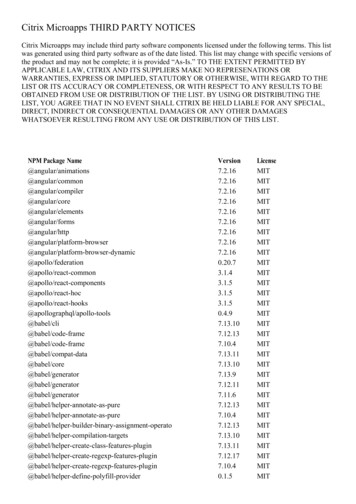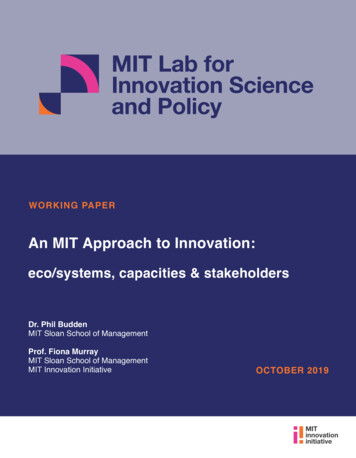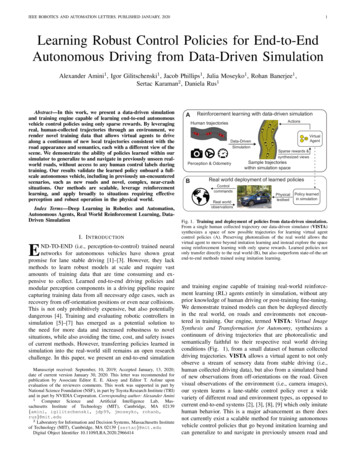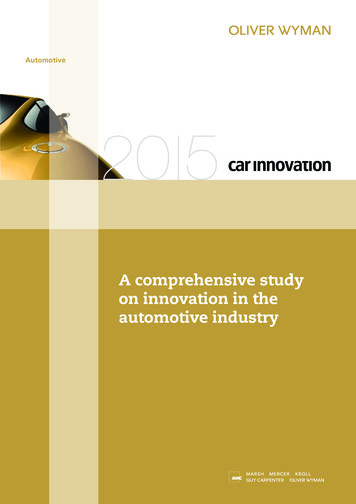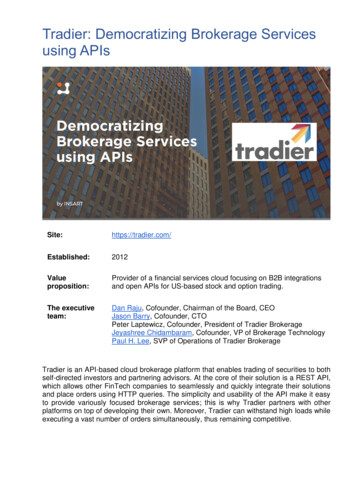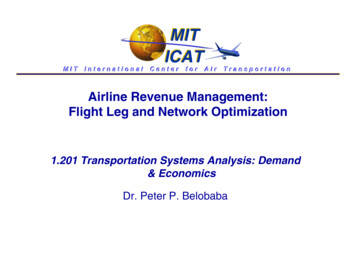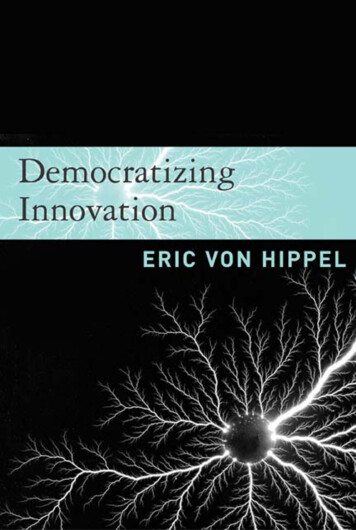
Transcription
Democratizing Innovation
Democratizing InnovationEric von HippelThe MIT PressCambridge, MassachusettsLondon, England
2005 Eric von HippelExclusive rights to publish and sell this book in print form in English are licensed toThe MIT Press. All other rights are reserved by the author. An electronic version ofthis book is available under a Creative Commons license.MIT Press books may be purchased at special quantity discounts for business or salespromotional use. For information, please email special sales@mitpress.mit.edu orwrite to Special Sales Department, The MIT Press, 5 Cambridge Center, Cambridge,MA 02142.Set in Stone sans and Stone serif by The MIT Press. Printed and bound in the UnitedStates of America.Library of Congress Cataloging-in-Publication DataHippel, Eric von.Democratizing innovation / Eric von Hippel.p. cm.Includes bibliographical references and index.ISBN 0-262-00274-41. Technological innovations—Economic aspects. 2. Diffusion of innovations.3. Democracy. I. Title.HC79.T4H558 2005338'.064—dc22200406106010 9 8 7 6 5 4 3 2
Dedicated to all who are building the information commons.
ContentsAcknowledgementsix1Introduction and Overview2Development of Products by Lead Users193Why Many Users Want Custom Products334Users’ Innovate-or-Buy Decisions5Users’ Low-Cost Innovation Niches6Why Users Often Freely Reveal Their Innovations7Innovation Communities8Adapting Policy to User Innovation9Democratizing Innovation10Application: Searching for Lead User Innovations11Application: Toolkits for User Innovation and Custom Design12Linking User Innovation to Other Phenomena and 21133165147
AcknowledgementsEarly in my research on the democratization of innovation I was very fortunate to gain five major academic mentors and friends. Nathan Rosenberg,Richard Nelson, Zvi Griliches, Edwin Mansfield, and Ann Carter all provided crucial support as I adopted economics as the organizing frameworkand toolset for my work. Later, I collaborated with a number of wonderfulco-authors, all of whom are friends as well: Stan Finkelstein, NikolausFranke, Dietmar Harhoff, Joachim Henkel, Cornelius Herstatt, Ralph Katz,Georg von Krogh, Karim Lakhani, Gary Lilien, Christian Luthje, PamelaMorrison, William Riggs, John Roberts, Stephan Schrader, Mary Sonnack,Stefan Thomke, Marcie Tyre, and Glen Urban. Other excellent research collaborators and friends of long standing include Carliss Baldwin, SonaliShah, Sarah Slaughter, and Lars Jeppesen.At some point as interest in a topic grows, there is a transition fromdyadic academic relationships to a real research community. In my case, theessential person in enabling that transition was my close friend and colleague Dietmar Harhoff. He began to send wonderful Assistant Professors(Habilitanden) over from his university, Ludwig Maximilians Universität inMunich, to do collaborative research with me as MIT Visiting Scholars. Theyworked on issues related to the democratization of innovation while at MITand then carried on when they returned to Europe. Now they are trainingothers in their turn.I have also greatly benefited from close contacts with colleagues inindustry. As Director of the MIT Innovation Lab, I work together withsenior innovation managers in just a few companies to develop and try outinnovation tools in actual company settings. Close intellectual colleaguesand friends of many years standing in this sphere include Jim Euchnerfrom Pitney-Bowes, Mary Sonnack and Roger Lacey from 3M, John Wright
xAcknowledgementsfrom IFF, Dave Richards from Nortel Networks, John Martin from Verizon,Ben Hyde from the Apache Foundation, Brian Behlendorf from the ApacheFoundation and CollabNet, and Joan Churchill and Susan Hiestand fromLead User Concepts. Thank you so much for the huge (and often humbling)insights that your and our field experimentation has provided!I am also eager to acknowledge and thank my family for the joy andlearning they experience and share with me. My wife Jessie is a professionaleditor and edited my first book in a wonderful way. For this book, however,time devoted to bringing up the children made a renewed editorial collaboration impossible. I hope the reader will not suffer unduly as a consequence! My children Christiana Dagmar and Eric James have watched mework on the book—indeed they could not avoid it as I often write at home.I hope they have been drawing the lesson that academic research can bereally fun. Certainly, that is the lesson I drew from my father, Arthur vonHippel. He wrote his books in his study upstairs when I was a child andwould often come down to the kitchen for a cup of coffee. In transit, hewould throw up his hands and say, to no one in particular, “Why do Ichoose to work on such difficult problems?” And then he would lookdeeply happy. Dad, I noticed the smile!Finally my warmest thanks to my MIT colleagues and students and alsoto MIT as an institution. MIT is a really inspiring place to work and learnfrom others. We all understand the requirements for good research andlearning, and we all strive to contribute to a very supportive academic environment. And, of course, new people are always showing up with new andinteresting ideas, so fun and learning are always being renewed!
Democratizing Innovation
1Introduction and OverviewWhen I say that innovation is being democratized, I mean that users ofproducts and services—both firms and individual consumers—are increasingly able to innovate for themselves. User-centered innovation processesoffer great advantages over the manufacturer-centric innovation development systems that have been the mainstay of commerce for hundreds ofyears. Users that innovate can develop exactly what they want, rather thanrelying on manufacturers to act as their (often very imperfect) agents.Moreover, individual users do not have to develop everything they need ontheir own: they can benefit from innovations developed and freely sharedby others.The trend toward democratization of innovation applies to informationproducts such as software and also to physical products. As a quick illustration of the latter, consider the development of high-performance windsurfing techniques and equipment in Hawaii by an informal user group.High-performance windsurfing involves acrobatics such as jumps and flipsand turns in mid-air. Larry Stanley, a pioneer in high-performance windsurfing, described the development of a major innovation in technique andequipment to Sonali Shah:In 1978 Jürgen Honscheid came over from West Germany for the first HawaiianWorld Cup and discovered jumping, which was new to him, although Mike Horganand I were jumping in 1974 and 1975. There was a new enthusiasm for jumping andwe were all trying to outdo each other by jumping higher and higher. The problemwas that . . . the riders flew off in mid-air because there was no way to keep the boardwith you—and as a result you hurt your feet, your legs, and the board.Then I remembered the “Chip,” a small experimental board we had built withfootstraps, and thought “it’s dumb not to use this for jumping.” That’s when I firststarted jumping with footstraps and discovering controlled flight. I could go so muchfaster than I ever thought and when you hit a wave it was like a motorcycle rider
2Chapter 1hitting a ramp; you just flew into the air. All of a sudden not only could you fly intothe air, but you could land the thing, and not only that, but you could change direction in the air!The whole sport of high-performance windsurfing really started from that. As soonas I did it, there were about ten of us who sailed all the time together and within oneor two days there were various boards out there that had footstraps of various kindson them, and we were all going fast and jumping waves and stuff. It just kind ofsnowballed from there. (Shah 2000)By 1998, more than a million people were engaged in windsurfing, and alarge fraction of the boards sold incorporated the user-developed innovations for the high-performance sport.The user-centered innovation process just illustrated is in sharp contrastto the traditional model, in which products and services are developed bymanufacturers in a closed way, the manufacturers using patents, copyrights,and other protections to prevent imitators from free riding on their innovation investments. In this traditional model, a user’s only role is to haveneeds, which manufacturers then identify and fill by designing and producing new products. The manufacturer-centric model does fit some fieldsand conditions. However, a growing body of empirical work shows thatusers are the first to develop many and perhaps most new industrial andconsumer products. Further, the contribution of users is growing steadilylarger as a result of continuing advances in computer and communicationscapabilities.In this book I explain in detail how the emerging process of user-centric,democratized innovation works. I also explain how innovation by usersprovides a very necessary complement to and feedstock for manufacturerinnovation.The ongoing shift of innovation to users has some very attractive qualities. It is becoming progressively easier for many users to get preciselywhat they want by designing it for themselves. And innovation by usersappears to increase social welfare. At the same time, the ongoing shift ofproduct-development activities from manufacturers to users is painful anddifficult for many manufacturers. Open, distributed innovation is “attacking” a major structure of the social division of labor. Many firms andindustries must make fundamental changes to long-held business modelsin order to adapt. Further, governmental policy and legislation sometimespreferentially supports innovation by manufacturers. Considerations ofsocial welfare suggest that this must change. The workings of the intellec-
Introduction and Overview3tual property system are of special concern. But despite the difficulties, ademocratized and user-centric system of innovation appears well worthstriving for.Users, as the term will be used in this book, are firms or individual consumers that expect to benefit from using a product or a service. In contrast,manufacturers expect to benefit from selling a product or a service. A firmor an individual can have different relationships to different products orinnovations. For example, Boeing is a manufacturer of airplanes, but it isalso a user of machine tools. If we were examining innovations developedby Boeing for the airplanes it sells, we would consider Boeing a manufacturer-innovator in those cases. But if we were considering innovations inmetal-forming machinery developed by Boeing for in-house use in building airplanes, we would categorize those as user-developed innovationsand would categorize Boeing as a user-innovator in those cases.Innovation user and innovation manufacturer are the two general“functional” relationships between innovator and innovation. Users areunique in that they alone benefit directly from innovations. All others(here lumped under the term “manufacturers”) must sell innovationrelated products or services to users, indirectly or directly, in order to profitfrom innovations. Thus, in order to profit, inventors must sell or licenseknowledge related to innovations, and manufacturers must sell productsor services incorporating innovations. Similarly, suppliers of innovationrelated materials or services—unless they have direct use for the innovations—must sell the materials or services in order to profit from theinnovations.The user and manufacturer categorization of relationships betweeninnovator and innovation can be extended to specific functions, attributes,or features of products and services. When this is done, it may turn outthat different parties are associated with different attributes of a particularproduct or service. For example, householders are the users of the switching attribute of a household electric light switch—they use it to turn lightson and off. However, switches also have other attributes, such as “easywiring” qualities, that may be used only by the electricians who installthem. Therefore, if an electrician were to develop an improvement to theinstallation attributes of a switch, it would be considered a user-developedinnovation.A brief overview of the contents of the book follows.
4Chapter 1Development of Products by Lead Users (Chapter 2)Empirical studies show that many users—from 10 percent to nearly 40 percent—engage in developing or modifying products. About half of thesestudies do not determine representative innovation frequencies; they weredesigned for other purposes. Nonetheless, when taken together, the findings make it very clear that users are doing a lot of product modification andproduct development in many fields.Studies of innovating users (both individuals and firms) show them tohave the characteristics of “lead users.” That is, they are ahead of the majority of users in their populations with respect to an important market trend,and they expect to gain relatively high benefits from a solution to the needsthey have encountered there. The correlations found between innovationby users and lead user status are highly significant, and the effects are verylarge.Since lead users are at the leading edge of the market with respect toimportant market trends, one can guess that many of the novel productsthey develop for their own use will appeal to other users too and so mightprovide the basis for products manufacturers would wish to commercialize. This turns out to be the case. A number of studies have shown thatmany of the innovations reported by lead users are judged to becommercially attractive and/or have actually been commercialized bymanufacturers.Research provides a firm grounding for these empirical findings. Thetwo defining characteristics of lead users and the likelihood that they willdevelop new or modified products have been found to be highly correlated (Morrison et al. 2004). In addition, it has been found that the higherthe intensity of lead user characteristics displayed by an innovator, thegreater the commercial attractiveness of the innovation that the lead userdevelops (Franke and von Hippel 2003a). In figure 1.1, the increased concentration of innovations toward the right indicates that the likelihoodof innovating is higher for users having higher lead user index values.The rise in average innovation attractiveness as one moves from left toright indicates that innovations developed by lead users tend to be morecommercially attractive. (Innovation attractiveness is the sum of the novelty of the innovation and the expected future generality of marketdemand.)
Introduction and Overview5Attractiveness of innovationsInnovation10Estimated OLS curve50234567891011121314“Lead-user-ness” of usersFigure 1.1User-innovators with stronger “lead user” characteristics develop innovations havinghigher appeal in the general marketplace. Estimated OLS function: Y 2.06 0.57x,where Y represents attractiveness of innovation and x represents lead-user-ness ofrespondent. Adjusted R2 0.281; p 0.002; n 30. Source of data: Franke and vonHippel 2003.Why Many Users Want Custom Products (Chapter 3)Why do so many users develop or modify products for their own use? Usersmay innovate if and as they want something that is not available on themarket and are able and willing to pay for its development. It is likely thatmany users do not find what they want on the market. Meta-analysis ofmarket-segmentation studies suggests that users’ needs for products arehighly heterogeneous in many fields (Franke and Reisinger 2003).Mass manufacturers tend to follow a strategy of developing products thatare designed to meet the needs of a large market segment well enough toinduce purchase from and capture significant profits from a large numberof customers. When users’ needs are heterogeneous, this strategy of “a fewsizes fit all” will leave many users somewhat dissatisfied with the commercial products on offer and probably will leave some users seriously dissatisfied. In a study of a sample of users of the security features of Apache webserver software, Franke and von Hippel (2003b) found that users had a veryhigh heterogeneity of need, and that many had a high willingness to pay to
6Chapter 1get precisely what they wanted. Nineteen percent of the users sampled actually innovated to tailor Apache more closely to their needs. Those who didwere found to be significantly more satisfied.Users’ Innovate-or-Buy Decisions (Chapter 4)Even if many users want “exactly right products” and are willing and able topay for their development, why do users often do this for themselves ratherthan hire a custom manufacturer to develop a special just-right product forthem? After all, custom manufacturers specialize in developing products forone or a few users. Since these firms are specialists, it is possible that theycould design and build custom products for individual users or user firmsfaster, better, or cheaper than users could do this for themselves. Despite thispossibility, several factors can drive users to innovate rather than buy. Bothin the case of user firms and in the case of individual user-innovators, agencycosts play a major role. In the case of individual user-innovators, enjoymentof the innovation process can also be important.With respect to agency costs, consider that when a user develops its owncustom product that user can be trusted to act in its own best interests.When a user hires a manufacturer to develop a custom product, the situation is more complex. The user is then a principal that has hired the custom manufacturer to act as its agent. If the interests of the principal and theagent are not the same, there will be agency costs. In general terms, agencycosts are (1) costs incurred to monitor the agent to ensure that it (or he orshe) follows the interests of the principal, (2) the cost incurred by the agentto commit itself not to act against the principal’s interest (the “bondingcost”), and (3) costs associated with an outcome that does not fully servethe interests of the principal (Jensen and Meckling 1976). In the specificinstance of product and service development, a major divergence of interests between user and custom manufacturer does exist: the user wants to getprecisely what it needs, to the extent that it can afford to do so. In contrast,the custom manufacturer wants to lower its development costs by incorporating solution elements it already has or that it predicts others will want inthe future—even if by doing so it does not serve its present client’s needs aswell as it could.A user wants to preserve its need specification because that specificationis chosen to make that user’s overall solution quality as high as possible at
Introduction and Overview7the desired price. For example, an individual user may specify a mountainclimbing boot that will precisely fit his unique climbing technique andallow him to climb Everest more easily. Any deviations in boot design willrequire compensating modifications in the climber’s carefully practiced anddeeply ingrained climbing technique—a much more costly solution fromthe user’s point of view. A custom boot manufacturer, in contrast, will havea strong incentive to incorporate the materials and processes it has in stockand expects to use in future even if this produces a boot that is not preciselyright for the present customer. For example, the manufacturer will not wantto learn a new way to bond boot components together even if that wouldproduce the best custom result for one client. The net result is that whenone or a few users want something special they will often get the best resultby innovating for themselves.A small model of the innovate-or-buy decision follows. This modelshows in a quantitative way that user firms with unique needs will alwaysbe better off developing new products for themselves. It also shows thatdevelopment by manufacturers can be the most economical option when nor more user firms want the same thing. However, when the number of userfirms wanting the same thing falls between 1 and n, manufacturers may notfind it profitable to develop a new product for just a few users. In that case,more than one user may invest in developing the same thing independently, owing to market failure. This results in a waste of resources from thepoint of view of social welfare. The problem can be addressed by new institutional forms, such as the user innovation communities that will be studied later in this book.Chapter 4 concludes by pointing out that an additional incentive candrive individual user-innovators to innovate rather than buy: they mayvalue the process of innovating because of the enjoyment or learning that itbrings them. It might seem strange that user-innovators can enjoy productdevelopment enough to want to do it themselves—after all, manufacturerspay their product developers to do such work! On the other hand, it is alsoclear that enjoyment of problem solving is a motivator for many individualproblem solvers in at least some fields. Consider for example the millions ofcrossword-puzzle aficionados. Clearly, for these individuals enjoyment ofthe problem-solving process rather than the solution is the goal. One caneasily test this by attempting to offer a puzzle solver a completed puzzle—the very output he or she is working so hard to create. One will very likely
8Chapter 1be rejected with the rebuke that one should not spoil the fun! Pleasure as amotivator can apply to the development of commercially useful innovations as well. Studies of the motivations of volunteer contributors of codeto widely used software products have shown that these individuals too areoften strongly motivated to innovate by the joy and learning they find inthis work (Hertel et al. 2003; Lakhani and Wolf 2005).Users’ Low-Cost Innovation Niches (Chapter 5)An exploration of the basic processes of product and service developmentshow that users and manufacturers tend to develop different types of innovations. This is due in part to information asymmetries: users and manufacturers tend to know different things. Product developers need two types ofinformation in order to succeed at their work: need and context-of-use information (generated by users) and generic solution information (often initiallygenerated by manufacturers specializing in a particular type of solution).Bringing these two types of information together is not easy. Both needinformation and solution information are often very “sticky”—that is, costlyto move from the site where the information was generated to other sites. Asa result, users generally have a more accurate and more detailed model oftheir needs than manufacturers have, while manufacturers have a bettermodel of the solution approach in which they specialize than the user has.When information is sticky, innovators tend to rely largely on informationthey already have in stock. One consequence of the information asymmetrybetween users and manufacturers is that users tend to develop innovationsthat are functionally novel, requiring a great deal of user-need informationand use-context information for their development. In contrast, manufacturers tend to develop innovations that are improvements on well-knownneeds and that require a rich understanding of solution information for theirdevelopment. For example, firms that use inventory-management systems,such as retailers, tend to be the developers of new approaches to inventorymanagement. In contrast, manufacturers of inventory-management systemsand equipment tend to develop improvements to the equipment used toimplement these user-devised approaches (Ogawa 1998).If we extend the information-asymmetry argument one step further, wesee that information stickiness implies that information on hand will alsodiffer among individual users and manufacturers. The information assets of
Introduction and Overview9some particular user (or some particular manufacturer) will be closest towhat is required to develop a particular innovation, and so the cost of developing that innovation will be relatively low for that user or manufacturer.The net result is that user innovation activities will be distributed acrossmany users according to their information endowments. With respect toinnovation, one user is by no means a perfect substitute for another.Why Users Often Freely Reveal Their Innovations (Chapter 6)The social efficiency of a system in which individual innovations are developed by individual users is increased if users somehow diffuse what theyhave developed to others. Manufacturer-innovators partially achieve thiswhen they sell a product or a service on the open market (partially becausethey diffuse the product incorporating the innovation, but often not all theinformation that others would need to fully understand and replicate it). Ifuser-innovators do not somehow also diffuse what they have done, multiple users with very similar needs will have to independently develop verysimilar innovations—a poor use of resources from the viewpoint of socialwelfare. Empirical research shows that users often do achieve widespreaddiffusion by an unexpected means: they often “freely reveal” what theyhave developed. When we say that an innovator freely reveals informationabout a product or service it has developed, we mean that all intellectualproperty rights to that information are voluntarily given up by the innovator, and all interested parties are given access to it—the informationbecomes a public good.The empirical finding that users often freely reveal their innovations hasbeen a major surprise to innovation researchers. On the face of it, if a userinnovator’s proprietary information has value to others, one would thinkthat the user would strive to prevent free diffusion rather than help othersto free ride on what it has developed at private cost. Nonetheless, it is nowvery clear that individual users and user firms—and sometimes manufacturers—often freely reveal detailed information about their innovations.The practices visible in “open source” software development were important in bringing this phenomenon to general awareness. In these projects itwas clear policy that project contributors would routinely and systematicallyfreely reveal code they had developed at private expense (Raymond 1999).However, free revealing of product innovations has a history that began
10Chapter 1long before the advent of open source software. Allen, in his 1983 study ofthe eighteenth-century iron industry, was probably the first to consider thephenomon systematically. Later, Nuvolari (2004) discussed free revealing inthe early history of mine pumping engines. Contemporary free revealing byusers has been documented by von Hippel and Finkelstein (1979) for medical equipment, by Lim (2000) for semiconductor process equipment, byMorrison, Roberts, and von Hippel (2000) for library information systems,and by Franke and Shah (2003) for sporting equipment. Henkel (2003) hasdocumented free revealing among manufacturers in the case of embeddedLinux software.Innovators often freely reveal because it is often the best or the only practical option available to them. Hiding an innovation as a trade secret isunlikely to be successful for long: too many generally know similar things,and some holders of the “secret” information stand to lose little or nothingby freely revealing what they know. Studies find that innovators in manyfields view patents as having only limited value. Copyright protection andcopyright licensing are applicable only to “writings,” such as books, graphicimages, and computer software.Active efforts by innovators to freely reveal—as opposed to sullen acceptance—are explicable because free revealing can provide innovators with significant private benefits as well as losses or risks of loss. Users who freelyreveal what they have done often find that others then improve or suggestimprovements to the innovation, to mutual benefit (Raymond 1999). Freelyrevealing users also may benefit from enhancement of reputation, frompositive network effects due to increased diffusion of their innovation, andfrom other factors. Being the first to freely reveal a particular innovationcan also enhance the benefits received, and so there can actually be a rushto reveal, much as scientists rush to publish in order to gain the benefitsassociated with being the first to have made a particular advancement.Innovation Communities (Chapter 7)Innovation by users tends to be widely distributed rather than concentratedamong just a very few very innovative users. As a result, it is important foruser-innovators to find ways to combine and leverage their efforts. Usersachieve this by engaging in many forms of cooperation. Direct, informaluser-to-user cooperation (assisting others to innovate, answering questions,
Introduction and Overview11and so on) is common. Organized cooperation is also common, with usersjoining together in networks and communities that provide useful structures and tools for their interactions and for the distribution of innovations.Innovation communities can increase the speed and effectiveness withwhich users and also manufacturers can develop and test and diffuse theirinnovations. They also can greatly increase the ease with which innovatorscan build larger systems from interlinkable modules created by communityparticipants.Free and open source software projects are a relatively well-developed andvery successful form of Internet-based innovation community. However,innovation communities are by no means restricted to software or even toinformation products, and they can play a major role in the developmentof physical products. Franke and Shah (2003) have documented the valuethat user innovation communities can provide to user-innov
In this book I explain in detail how the emerging process of user-centric, democratized innovation works. I also explain how innovation by users provides a very necessary complement to and feedstock for manufacturer innovation. The ongoing shift of innovation to users has some very attractive qual-ities.
